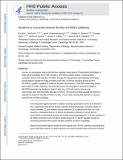Sestrin2 is a leucine sensor for the mTORC1 pathway
Author(s)
Shen, K.; Cantor, J. R.; Wolfson, Rachel Laura; Chantranupong, Lynne; Saxton, Robert Andrew; Scaria, Sonia M.; Sabatini, David; ... Show more Show less
DownloadSabatini_Sestrin2 is a leucine.pdf (1.422Mb)
PUBLISHER_POLICY
Publisher Policy
Article is made available in accordance with the publisher's policy and may be subject to US copyright law. Please refer to the publisher's site for terms of use.
Terms of use
Metadata
Show full item recordAbstract
Leucine is a proteogenic amino acid that also regulates many aspects of mammalian physiology, in large part by activating the mTOR complex 1 (mTORC1) protein kinase, a master growth controller. Amino acids signal to mTORC1 through the Rag guanosine triphosphatases (GTPases). Several factors regulate the Rags, including GATOR1, aGTPase-activating protein; GATOR2, a positive regulator of unknown function; and Sestrin2, a GATOR2-interacting protein that inhibits mTORC1 signaling. We find that leucine, but not arginine, disrupts the Sestrin2-GATOR2 interaction by binding to Sestrin2 with a dissociation constant of 20 micromolar, which is the leucine concentration that half-maximally activates mTORC1. The leucine-binding capacity of Sestrin2 is required for leucine to activate mTORC1 in cells. These results indicate that Sestrin2 is a leucine sensor for the mTORC1 pathway.
Date issued
2016-01Department
Massachusetts Institute of Technology. Institute for Medical Engineering & Science; Massachusetts Institute of Technology. Department of Biology; Koch Institute for Integrative Cancer Research at MITJournal
Science
Publisher
American Association for the Advancement of Science (AAAS)
Citation
Wolfson, R. L., L. Chantranupong, R. A. Saxton, K. Shen, S. M. Scaria, J. R. Cantor, and D. M. Sabatini. “Sestrin2 Is a Leucine Sensor for the mTORC1 Pathway.” Science 351, no. 6268 (October 8, 2015): 43–48. © 2016 American Association for the Advancement of Science
Version: Author's final manuscript
ISSN
0036-8075
1095-9203